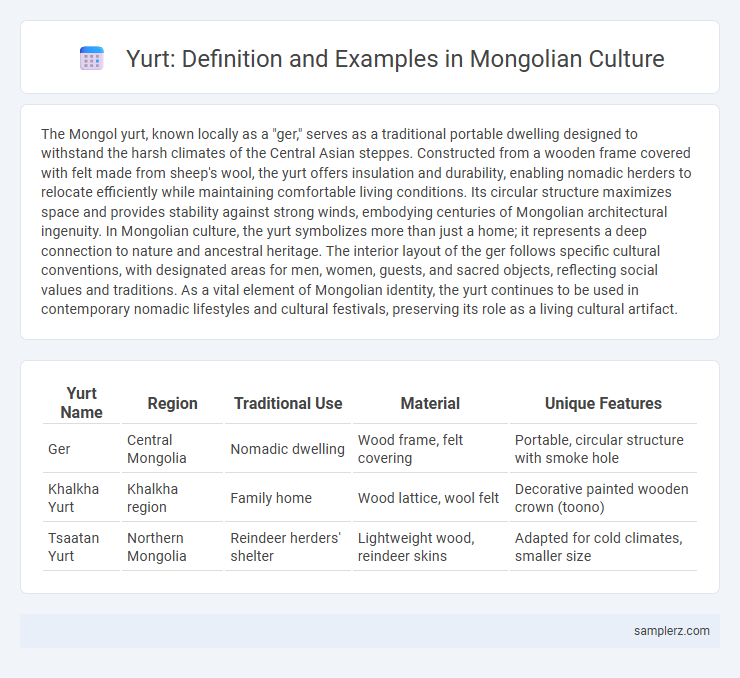The Mongol yurt, known locally as a "ger," serves as a traditional portable dwelling designed to withstand the harsh climates of the Central Asian steppes. Constructed from a wooden frame covered with felt made from sheep's wool, the yurt offers insulation and durability, enabling nomadic herders to relocate efficiently while maintaining comfortable living conditions. Its circular structure maximizes space and provides stability against strong winds, embodying centuries of Mongolian architectural ingenuity. In Mongolian culture, the yurt symbolizes more than just a home; it represents a deep connection to nature and ancestral heritage. The interior layout of the ger follows specific cultural conventions, with designated areas for men, women, guests, and sacred objects, reflecting social values and traditions. As a vital element of Mongolian identity, the yurt continues to be used in contemporary nomadic lifestyles and cultural festivals, preserving its role as a living cultural artifact.
Table of Comparison
| Yurt Name | Region | Traditional Use | Material | Unique Features |
|---|---|---|---|---|
| Ger | Central Mongolia | Nomadic dwelling | Wood frame, felt covering | Portable, circular structure with smoke hole |
| Khalkha Yurt | Khalkha region | Family home | Wood lattice, wool felt | Decorative painted wooden crown (toono) |
| Tsaatan Yurt | Northern Mongolia | Reindeer herders' shelter | Lightweight wood, reindeer skins | Adapted for cold climates, smaller size |
Historical Significance of the Mongolian Yurt
The Mongolian yurt, known as a ger, has been a central element of nomadic life for over 3,000 years, showcasing ingenious design adapted to the harsh steppes. Its circular shape and portable wooden framework covered with felt provide insulation against extreme temperatures, embodying the resourcefulness of Mongol culture. Historically, the yurt facilitated mobility for Mongol tribes, enabling swift expansion and effective governance during the era of Genghis Khan's empire.
Traditional Materials Used in Mongol Yurts
Mongol yurts, also known as gers, are traditionally constructed using a wooden frame made from lightweight, flexible willow or birch poles, providing a sturdy yet portable structure. The frame is covered with layers of felt made from sheep's wool, which offers excellent insulation against Mongolia's harsh climate by retaining heat during freezing winters and coolness in summer. Outer coverings often include canvas or animal hides, ensuring durability and protection from strong winds and rain on the vast steppes.
Architectural Design and Structure of Yurts
Mongol yurts feature a circular wooden frame with a lattice wall and a collapsible roof supported by radial rafters converging at a central crown, known as the toono. The structure is covered with felt made from compressed sheep's wool, providing insulation and protection from harsh weather. This portable design allows for easy assembly and disassembly, reflecting the nomadic lifestyle of the Mongolian people.
Cultural Symbolism of Yurts in Mongolian Society
Yurts in Mongolian society symbolize a deep connection to nomadic heritage and communal values, reflecting adaptability to the harsh Steppe environment. Their circular design represents unity and harmony, embodying the Mongols' respect for nature and family cohesion. These portable homes serve not only as dwellings but also as cultural icons preserving the identity and traditions of Mongolian nomads.
Daily Life Inside a Mongol Yurt
Daily life inside a Mongol yurt centers around its practical design, featuring a circular wooden frame covered with felt made from sheep's wool, providing insulation against harsh temperatures. The interior is organized with a hearth at the center for cooking and heating, surrounded by low beds and storage chests, reflecting the nomadic lifestyle's emphasis on mobility and efficiency. Personal and communal activities blend seamlessly in this space, supporting family cohesion and cultural traditions integral to Mongol identity.
Seasonal Adaptations of Yurts in Mongolia
Mongolian yurts, or gers, showcase remarkable seasonal adaptations designed to withstand harsh continental climates. Their felt insulation, made from sheep wool, provides exceptional thermal efficiency, retaining warmth during frigid winters and allowing ventilation in hot summers. The wooden lattice structure enables flexibility and easy disassembly, facilitating nomadic mobility aligned with seasonal grazing patterns.
Yurts in Mongol Festivals and Celebrations
Yurts in Mongol festivals and celebrations symbolize traditional nomadic life, serving as central gathering spaces for communal feasts and rituals. These portable, circular tents are often ornately decorated with colorful patterns that reflect Mongolian heritage and spiritual beliefs. During Naadam and Tsagaan Sar festivals, yurts act as cultural hubs where music, dance, and storytelling preserve ancient customs.
Craftsmanship and Decoration of Mongolian Yurts
Mongolian yurts, or gers, showcase expert craftsmanship through their intricate wooden latticework and sturdy, flexible framework designed to withstand harsh climates. The decoration of these yurts features vibrant textiles, including embroidered silk and felt panels adorned with symbolic patterns representing Mongolian heritage and spiritual beliefs. Skilled artisans meticulously create these elements, blending functionality with cultural expression in both form and ornamentation.
Evolution of Yurts in Contemporary Mongolian Culture
Yurts, traditionally used by Mongolian nomads, have evolved in contemporary Mongolian culture to incorporate modern materials such as steel frames and synthetic fabrics while preserving their iconic circular design. This blend of tradition and innovation allows yurts to serve as year-round homes, community centers, and tourist accommodations, reflecting Mongolia's adaptation to urbanization and increased environmental awareness. The contemporary yurt remains a powerful symbol of Mongolian identity, bridging the past and present through sustainable architecture and cultural heritage.
Comparative Analysis: Mongol Yurts and Other Nomadic Dwellings
Mongol yurts, known as gers, feature a circular wooden frame covered with felt, providing exceptional insulation and portability suited to the harsh Central Asian climate. Compared to the rectangular tents of the Bedouins or the tipi structures of Native American tribes, yurts offer a unique balance of durability and ease of assembly, supporting the Mongol nomadic lifestyle. Their design emphasizes centralized heat distribution and wind resistance, distinguishing them from other nomadic dwellings and reflecting adaptation to specific environmental and cultural needs.

example of yurt in Mongol Infographic
 samplerz.com
samplerz.com